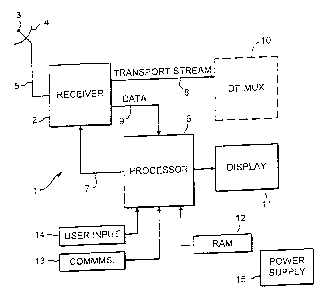Some of the information on this Web page has been provided by external sources. The Government of Canada is not responsible for the accuracy, reliability or currency of the information supplied by external sources. Users wishing to rely upon this information should consult directly with the source of the information. Content provided by external sources is not subject to official languages, privacy and accessibility requirements.
Any discrepancies in the text and image of the Claims and Abstract are due to differing posting times. Text of the Claims and Abstract are posted:
| (12) Patent: | (11) CA 2346832 |
|---|---|
| (54) English Title: | AN ANTENNA ALIGNMENT METER |
| (54) French Title: | DISPOSITIF DE MESURE D'ALIGNEMENT D'ANTENNE |
| Status: | Expired and beyond the Period of Reversal |
| (51) International Patent Classification (IPC): |
|
|---|---|
| (72) Inventors : |
|
| (73) Owners : |
|
| (71) Applicants : |
|
| (74) Agent: | MOFFAT & CO. |
| (74) Associate agent: | |
| (45) Issued: | 2004-11-30 |
| (86) PCT Filing Date: | 1999-10-15 |
| (87) Open to Public Inspection: | 2000-04-27 |
| Examination requested: | 2001-04-10 |
| Availability of licence: | N/A |
| Dedicated to the Public: | N/A |
| (25) Language of filing: | English |
| Patent Cooperation Treaty (PCT): | Yes |
|---|---|
| (86) PCT Filing Number: | PCT/GB1999/003418 |
| (87) International Publication Number: | WO 2000024083 |
| (85) National Entry: | 2001-04-10 |
| (30) Application Priority Data: | ||||||
|---|---|---|---|---|---|---|
|
An antenna alignment meter (1) comprises a receiver (2) for detecting a
signal with predetermined characteristics and outputting data pertaining to
the detection
of the signal, and a controller (6) responsive to the data from the receiver
for controlling
generation of an indicator that the signal has been detected. The meter can be
used for
aligning an antenna with a signal source. The meter is arranged to monitor
signals
received by the antenna and to provide an indication of correct alignment of
the antenna
with a desired signal source when a signal of a predetermined frequency,
polarization,
symbol rate and error correction ratio is received.
L'invention concerne un dispositif de mesure d'alignement d'antenne (1) comportant un récepteur (2) pour détecter un signal présentant des caractéristiques prédéterminées et produire des données relatives à la détection du signal, et un organe de commande (6) sensible aux données provenant du récepteur pour commander la production d'un indicateur indiquant que le signal a été détecté. Le dispositif de mesure peut être utilisé pour aligner une antenne sur une source de signaux. Le dispositif de mesure est conçu pour surveiller des signaux reçus par l'antenne et pour indiquer l'alignement correct de l'antenne sur une source de signaux voulue lors de la réception d'un signal présentant une fréquence, une polarisation, un débit de symboles et un taux de correction d'erreurs prédéterminés.
Note: Claims are shown in the official language in which they were submitted.
Note: Descriptions are shown in the official language in which they were submitted.

2024-08-01:As part of the Next Generation Patents (NGP) transition, the Canadian Patents Database (CPD) now contains a more detailed Event History, which replicates the Event Log of our new back-office solution.
Please note that "Inactive:" events refers to events no longer in use in our new back-office solution.
For a clearer understanding of the status of the application/patent presented on this page, the site Disclaimer , as well as the definitions for Patent , Event History , Maintenance Fee and Payment History should be consulted.
| Description | Date |
|---|---|
| Time Limit for Reversal Expired | 2017-10-16 |
| Letter Sent | 2016-10-17 |
| Inactive: IPC expired | 2015-01-01 |
| Grant by Issuance | 2004-11-30 |
| Inactive: Cover page published | 2004-11-29 |
| Inactive: Final fee received | 2004-09-20 |
| Pre-grant | 2004-09-20 |
| Notice of Allowance is Issued | 2004-04-16 |
| Letter Sent | 2004-04-16 |
| Notice of Allowance is Issued | 2004-04-16 |
| Inactive: Approved for allowance (AFA) | 2004-03-23 |
| Inactive: IPRP received | 2003-10-24 |
| Amendment Received - Voluntary Amendment | 2003-05-12 |
| Inactive: S.30(2) Rules - Examiner requisition | 2003-02-11 |
| Inactive: Correspondence - Formalities | 2001-08-23 |
| Letter Sent | 2001-08-21 |
| Inactive: Cover page published | 2001-07-12 |
| Inactive: Single transfer | 2001-07-05 |
| Inactive: First IPC assigned | 2001-06-27 |
| Inactive: Courtesy letter - Evidence | 2001-06-19 |
| Inactive: Acknowledgment of national entry - RFE | 2001-06-18 |
| Inactive: Correspondence - Formalities | 2001-06-13 |
| Application Received - PCT | 2001-06-09 |
| All Requirements for Examination Determined Compliant | 2001-04-10 |
| Request for Examination Requirements Determined Compliant | 2001-04-10 |
| Application Published (Open to Public Inspection) | 2000-04-27 |
There is no abandonment history.
The last payment was received on 2004-09-15
Note : If the full payment has not been received on or before the date indicated, a further fee may be required which may be one of the following
Please refer to the CIPO Patent Fees web page to see all current fee amounts.
Note: Records showing the ownership history in alphabetical order.
| Current Owners on Record |
|---|
| BRITISH SKY BROADCASTING LIMITED |
| Past Owners on Record |
|---|
| DAVID HOLLIDAY |